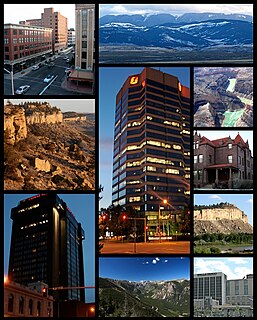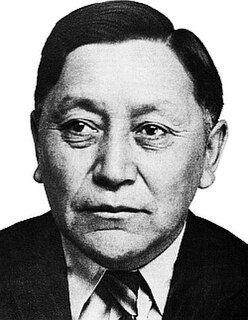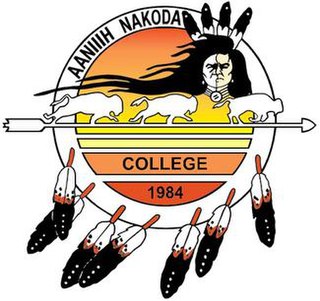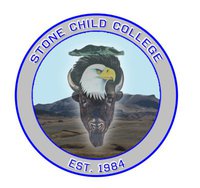Campus
The LBHC facility consists of 35,000 square feet of educational space. The LBHC campus is situated on two acres of wooded river valley. [2]
The campus has committed itself to sustainable energy with a goal of carbon neutrality (net-zero emissions). Throughout 2016 to 2016, the campus installed a 45-kilowatt photovoltaic system on the Health and Wellness Center to capture solar energy, partially funded via grants from the Office of Indian Energy Policy and Programs through the United States Department of Energy. [3]
In 2021, the college received a $100,000 grant from the Institute of Museum and Library Services to build a new cultural center and museum, and the planning committee input from the tribe to fill the "need for exhibits within the reservation constructed and interpreted by Indigenous people," citing a recent Crow exhibit at the Field Museum of Natural History in Chicago, Illinois, as an example of a museum ensuring active representation. [4] As part of the planning committee, Crow Studies adjunct instructor and state representative Sharon Stewart-Peregoy gave statements to local news for more use of the Crow language in the museum, in alignment with community requests. [5]

The Crow, whose autonym is Apsáalooke, also spelled Absaroka, are Native Americans living primarily in southern Montana. Today, the Crow people have a federally recognized tribe, the Crow Tribe of Montana, with an Indian reservation located in the south-central part of the state.

Crow Agency is a census-designated place (CDP) in Big Horn County, Montana, United States and is near the actual location for the Little Bighorn National Monument and re-enactment produced by the Real Bird family known as Battle of the Little Bighorn Reenactment. The population was 1,616 at the 2010 census. It is the governmental headquarters of the Crow Native Americans. It is also the location of the "agency offices" where the federal Superintendent of the Crow Indian Reservation and his staff interacts with the Crow Tribe, pursuant to federal treaties and statutes.

Billings is the largest city in the U.S. state of Montana, with a population of 117,116 as of 2020. Located in the south-central portion of the state, it is the seat of Yellowstone County and the principal city of the Billings Metropolitan Area, which had an population of 184,167 in the 2020 Census. It has a trade area of over 500,000.

The Little Bighorn River is a 138-mile-long (222 km) tributary of the Bighorn River in the United States in the states of Montana and Wyoming. The Battle of the Little Bighorn, also known as the Battle of the Greasy Grass, was fought on its banks on June 25–26, 1876, as well as the Battle of Crow Agency in 1887.
Northwest Indian College is a public tribal land-grant community college in Bellingham, Washington. It was established by the Lummi Nation and is the only accredited tribal college or university serving reservation communities of Washington, Oregon, and Idaho.

Joseph Medicine Crow was a Native American writer, historian and war chief of the Crow Nation. His writings on Native American history and reservation culture are considered seminal works, but he is best known for his writings and lectures concerning the Battle of the Little Bighorn of 1876.

The Wind River Indian Reservation, in the west-central portion of the U.S. state of Wyoming, is shared by two Native American tribes, the Eastern Shoshone and the Northern Arapaho. Roughly 60 mi (97 km) east to west by 50 mi (80 km) north to south, the Indian reservation is located in the Wind River Basin, and includes portions of the Wind River Range, Owl Creek Mountains, and Absaroka Range.

The Rosebud Indian Reservation (RIR) is an Indian reservation in South Dakota, United States. It is the home of the federally recognized Sicangu Oyate – also known as Sicangu Lakota, and the Rosebud Sioux Tribe (RST), a branch of the Lakota people. The Lakota name Sicangu Oyate translates into English as "Burnt Thigh Nation"; the French term "Brulé Sioux" is also used.

The Crow Indian Reservation is the homeland of the Crow Tribe. Established 1868, the reservation is located in parts of Big Horn, Yellowstone, and Treasure counties in southern Montana in the United States. The Crow Tribe has an enrolled membership of approximately 11,000, of whom 7,900 reside in the reservation. 20% speak Crow as their first language.

The Northern Cheyenne Tribe of the Northern Cheyenne Indian Reservation is the federally recognized Northern Cheyenne tribe. Located in southeastern Montana, the reservation is approximately 690 square miles (1,800 km2) in size and home to approximately 5,000 Cheyenne people. The tribal and government headquarters are located in Lame Deer, also the home of the annual Northern Cheyenne pow wow.

Robert Summers "Robbie" Yellowtail was a leader of the Crow Nation. Described as a "20th Century Warrior", Yellowtail was the first Native American to hold the post of Agency Superintendent at a reservation.
Nebraska Indian Community College (NICC) is a public tribal land-grant community college with three locations in Nebraska: Macy on the Omaha Tribe reservation, Santee on the Santee Sioux reservation, and the urban South Sioux City.

The Fort Peck Indian Reservation is located near Fort Peck, Montana, in the northeast part of the state. It is the home of several federally recognized bands of Assiniboine, Nakota, Lakota, and Dakota peoples of Native Americans.

In the United States, tribal colleges and universities (TCUs) are a category of higher education, minority-serving institutions defined in the Higher Education Act of 1965. Each qualifies for funding under the Tribally Controlled Colleges and Universities Assistance Act of 1978 or the Navajo Community College Act ; or is cited in section 532 of the Equity in Educational Land-Grant Status Act of 1994.
Janine Pease is an American educator and Native American advocate. She is the founding president of the Little Big Horn College as well as the past president of the American Indian Higher Education Consortium and director of the American Indian College Fund. She was appointed by President Bill Clinton to the National Advisory Council on Indian Education and the White House Initiative on Tribal Colleges and Universities Advisory Council. She has also served as a trustee of the Smithsonian National Museum of the American Indian.

Aaniiih Nakoda College is a public tribal land-grant community college on the Fort Belknap Indian Reservation in Harlem, Montana. The institution incorporates native culture into the curriculum and promotes cultural identity; however, the school is open to both tribal and non-tribal members. Aaniiih Nakoda College is a member of the American Indian Higher Education Consortium (AIHEC), which is a community of tribally and federally chartered institutions working to strengthen tribal nations and make a lasting difference in the lives of American Indians and Alaska Natives. ANC was created in response to the higher education needs of American Indians. ANC generally serves geographically isolated populations that have no other means accessing education beyond the high school level.

Stone Child College (SCC) is a public tribal land-grant community college in Box Elder, Montana. SCC is affiliated with the Chippewa-Cree Tribe and located on the Rocky Boy Indian Reservation in north central Montana; it is one of seven Tribal Colleges in Montana. In 2008–09, SCC had an enrollment of 511, of whom 98 percent were American Indian descent; 20 percent were bilingual or of limited English proficiency. SCC students range in age from 17 to 72, with the average age at 30. The college retention rate is 47 percent and the graduation rate is 20 percent.
Sharon Stewart-Peregoy is an American politician serving as a Democratic member of the Montana House of Representatives. She was first elected to the Montana House of Representatives in 2017, and represents House District 42. From 2009 to 2017, she served in Montana Senate, and represented Senate District 21, which included Crow Agency, Montana. She was a member of the Senate's American Indian Caucus. She received a Bachelor of Arts in elementary education from Montana State University and a Master of Education from City University at Seattle. She actively advocates for the revitalization of the Crow language and culture.

The Regional designations of Montana vary widely within the U.S state of Montana. The state is a large geographical area that is split by the Continental Divide, resulting in watersheds draining into the Pacific Ocean, Gulf of Mexico and Hudson's Bay. The state is approximately 545 miles (877 km) east to west along the Canada–United States border and 320 miles (510 km) north to south. The fourth largest state in land area, it has been divided up in official and unofficial ways into a variety of regions. Additionally, Montana is part of a number of larger federal government administrative regions.
Bently Spang is a Northern Cheyenne multidisciplinary artist, writer, and curator. His work has been exhibited widely in North America, South America, and Europe.















